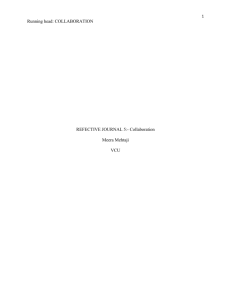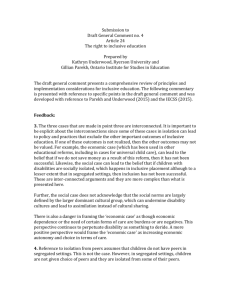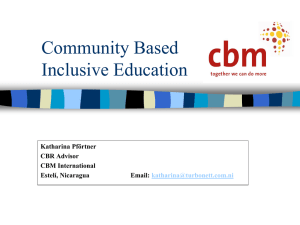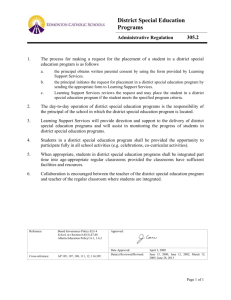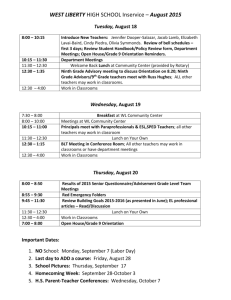File - Max Dodge-Harkins E
advertisement
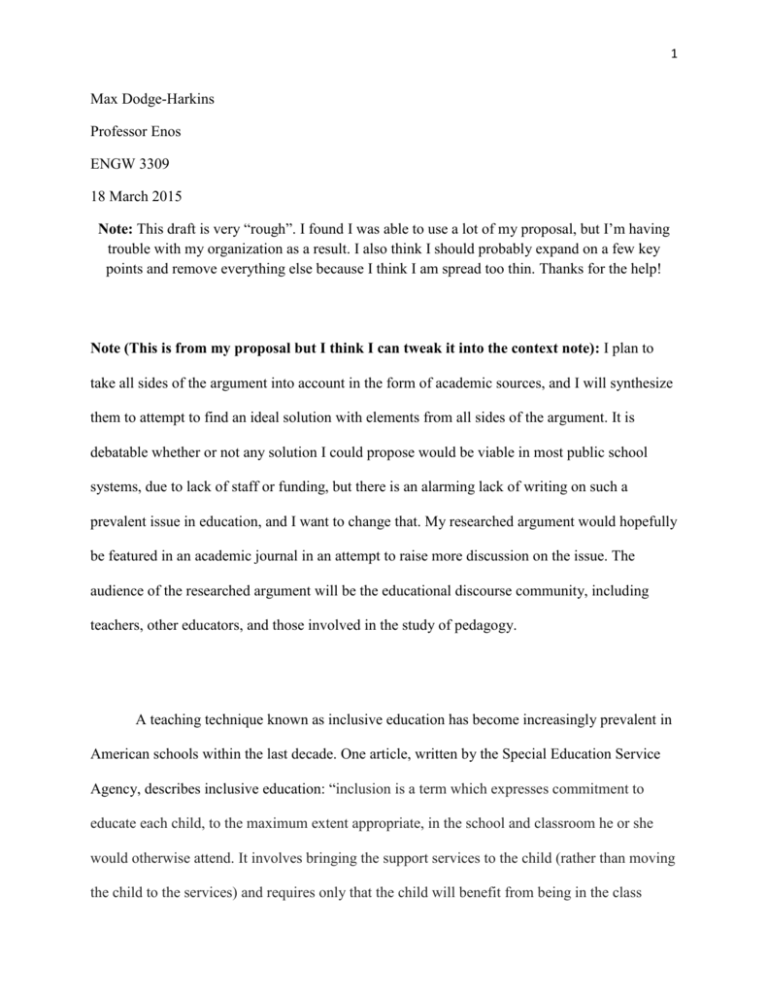
1 Max Dodge-Harkins Professor Enos ENGW 3309 18 March 2015 Note: This draft is very “rough”. I found I was able to use a lot of my proposal, but I’m having trouble with my organization as a result. I also think I should probably expand on a few key points and remove everything else because I think I am spread too thin. Thanks for the help! Note (This is from my proposal but I think I can tweak it into the context note): I plan to take all sides of the argument into account in the form of academic sources, and I will synthesize them to attempt to find an ideal solution with elements from all sides of the argument. It is debatable whether or not any solution I could propose would be viable in most public school systems, due to lack of staff or funding, but there is an alarming lack of writing on such a prevalent issue in education, and I want to change that. My researched argument would hopefully be featured in an academic journal in an attempt to raise more discussion on the issue. The audience of the researched argument will be the educational discourse community, including teachers, other educators, and those involved in the study of pedagogy. A teaching technique known as inclusive education has become increasingly prevalent in American schools within the last decade. One article, written by the Special Education Service Agency, describes inclusive education: “inclusion is a term which expresses commitment to educate each child, to the maximum extent appropriate, in the school and classroom he or she would otherwise attend. It involves bringing the support services to the child (rather than moving the child to the services) and requires only that the child will benefit from being in the class 2 (rather than having to keep up with the other students)” (SESA 2). More specifically, students with disabilities are placed into classrooms with their peers, instead of being grouped into a resource room. Depending on the severity of the disability and the specific case, resources are brought to the student in their regular classroom, or they are given a permanent aide. However, inclusive classrooms are not always ideal: a student, depending on his or her disability and educational needs, may require individualized instruction or precisely controlled environments that an inclusive classroom cannot provide. Inclusive classrooms are an effective means of providing children with disabilities necessarily social interaction with their peers, but for certain students it is at the cost of a higher quality education. I have personal experience on the inclusive classroom topic: I worked as an aide in a fourth grade classroom at the Cabot School in Newton, Massachusetts. The entire Newton school system utilizes inclusive classrooms, in part because of the affluence of the town. All four fourth grade classrooms had permanent aids, an opportunity most school systems cannot provide, and there were at least three children with disabilities in each classroom. In the classroom I worked in, there were six different students with different disabilities and none of them received the full attention they required. One of the fourth graders read at a kindergarten level and could not complete any of his work because he could not decipher the directions, and another student breezed through any work given to her with ease, yet she was prone to fits of rage and violence, including throwing multiple pencils at the principal of the school. These children can both be grouped into the category of “having disabilities” but their needs, in terms of education, are vastly different. Neither student fully benefits from being in an inclusive classroom, nor would it be ideal for them to be sent to a resource room. This example perfectly illustrates instances such as these need to be resolved on a case by case basis, with each child potentially requiring a 3 differing mode of education. There are multiple variables: the amount of time spent in the classroom, in independent instruction, or with peers who have similar disabilities. Inclusive classrooms are a step in the right direction, but in specific cases they hurt children more than they help them. There is a lack of current literature on the inclusive classroom argument, yet it is a debate that affects millions of children in the United States. The most recent stance on inclusive classrooms by the National Education Association, the nation’s largest and most powerful teacher’s union was approved in 1994. There has been a plethora of research regarding education in the past twenty years, so it is illogical that the inclusive classroom argument not been updated accordingly. The literature of the inclusive education field is in disagreement over fully integrated classrooms. One argument contends that “instruction, not setting, is the key to achievement of success as measured by student outcomes” (3). This source isn’t necessarily against inclusive classrooms, but the author finds that a high level of instruction more than where the student is educated matters most. Another source argues that even students with extremely debilitating disabilities need to be integrated into classrooms because of the first-hand human experiences. The author asserts that “students with severe disabilities can benefit from well-planned and organized integration experiences” (Cromwell 1). These are experiences these students miss in their education without inclusive classrooms, even if their “special education” teacher is exceptional. Another argument discusses the potential of a technique called co-teaching: “coteaching usually consists of one general education teacher paired with one special-education teacher in an inclusive classroom of general education and special education students” (Scruggs 392). Co-teaching is a compromise between inclusive and non-inclusive classrooms, and it attempts to improve upon inclusive classrooms with permanent or multiple alternating aides. 4 This is a valid method, yet in certain circumstances students may require more help than just two teachers could possibly provide. One article argues that even students with severe disabilities should be integrated into classrooms with their peers. It describes a student with a severe disability as "having physical, mental, or emotional problems to a degree requiring educational, social, psychological, and/or medical services beyond those traditionally offered by regular and special education". It contends that regardless how severe the disability, students should be involved with their peers and be integrated into inclusive classrooms. Inclusive classrooms can be a boon, but also a hindrance to children’s education. Some students fall behind because of less observable disabilities, such as dyslexia. They struggle to catch up to their peers because of a lack of proper support and this can negatively affect their psychological state: they do not necessarily realize that it is their disability that is slowing their improvement, and they think it’s their own lack of intelligence. An inclusive classroom would be ideal for a student like this, but only once they receive the proper one on one support and psychological guidance to return to the classroom and feel comfortable. Of course, these students need to interact with their classmates, but one on one, or small group lessons are the best way to educate specific students. There are no absolutes in terms of educating children with disabilities, and children should not always be integrated into classrooms. Another portion of the inclusive education literature puts forth the idea of co-teaching. In co-teaching there is a main teacher and a permanent “co-teacher” who attends mainly to the students with disabilities, but of course he or she is also available to assist to the other students. Co-teaching is a valid method in certain situations, but it also has its flaws. There could be some students who require a fulltime aide, yet others who only need occasional help to stay on track. Therefore, the co-teacher could be under or overworked depending on the situation, or they may 5 lack the necessary tools to help multiple children with differing disabilities that a specialized disabled student professional could handle more easily. Note: I want to add more onto my paper with these three sources: Cromwell, Sharon. "Inclusion In The Classroom: Has It Gone Too Far? "Education World. 27 Oct. 2011. Web. 23 Feb. 2015. <http://www.educationworld.com/a_curr/curr034.shtml>. This article outlines how the discussion on inclusive classrooms needs to be reopened and expanded upon on a national level. I will be using it to help me prove just how outdated the policies on inclusive classrooms really are, and although this article sounds similar to what I will be writing, it fails to put forth any solutions or how the educational discourse community should move forward. At the beginning of the year teachers have the goal of establishing a classroom environment that is favorable for helping all students work cooperatively in order to learn. The classroom environment can either improve or impede a student's ability to learn and feel safe and comfortable as a member of the class. Classrooms that encourage emotional well-being create an atmosphere for both learning and emotional development. Educational research supports creating an atmosphere of mutual respect, where students feel relaxed in asking questions and expressing their thoughts and feelings http://corescholar.libraries.wright.edu/cgi/viewcontent.cgi?article=1102&context=ejie Positive teacher attitudes are an important predictor of the successful education of children with disabilities, including those with autism spectrum disorders (ASDs). However, the severity and pervasiveness ASD often leads to the teaching and inclusion of this group of pupils to be seen as especially complex. Even teachers of recognized professional competence often consider themselves less able to deal with these students than with those with any other form of special needs http://www.ncbi.nlm.nih.gov/pmc/articles/PMC3420736/ 6 Response Letter Thank you for the help with revisions Hannah. I found many of your critiques very helpful: I agree that I should state my thesis more clearly in the beginning of my paper. Your discussion of the “inclusive classrooms are a step in the right direction” paragraph also aided me a lot in my revisions: I really needed to restructure the paragraph. I also appreciated how you pointed out I introduced co-teaching twice, it was probably confusing for the reader, but I somehow didn’t notice when I looked my paper over. Bibliography Cromwell, Sharon. "Inclusion In The Classroom: Has It Gone Too Far?"Education World. 27 Oct. 2011. Web. 23 Feb. 2015. <http://www.educationworld.com/a_curr/curr034.shtml>. Educational Resource Information Center. "Integrating Students with Severe Disabilities." Education.com. 26 July 2007. Web. 25 Feb. 2015. <http://www.education.com/reference/article/Ref_Integrating_Students/>. Scruggs, Thomas. "Co-Teaching in Inclusive Classrooms: A Metasynthesis of Qualitative Research." Education.ufl.edu. 1 Apr. 2007. Web. 25 Feb. 2015. <http://education.ufl.edu/325t/files/2013/06/Scrugg_2007.pdf>. Special Education Service Agency. "Educating Students with Disabilities in General Education Classrooms: A Summary of the Research." BSNPTA.org. 1 Jan. 1997. Web. 25 Feb. 2015. <http://bsnpta.org/user/Inclusion_Research_Summary.pdf>. 7

